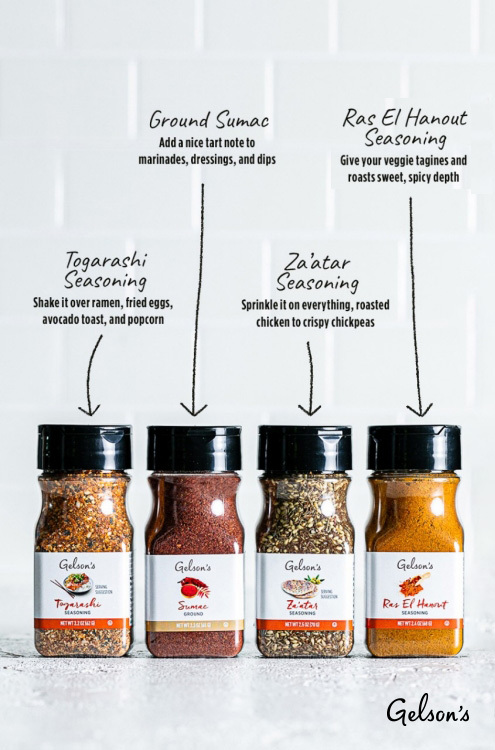Announcements
- Home /
- Announcements /
- A home cooks guide to gelsons spice blends
A Home Cook’s Guide to Gelson’s Spice Blends

We’ve just created a handful of new Gelson’s spice blends. They’re based on some classic and popular seasonings, made with the highest quality spices and herbs, and we love them unabashedly. In fact, they’re pretty much our new best friends, and we plan to keep them right next to the stove at all times.
Like all really good spice blends, they’re super versatile. They add layers of flavor to a recipe instantly — no toasting seeds, no mortar and pestle, just one jar and a quick shake of the wrist. Cutting down on salt? Lean into our spice blends and you won’t miss it at all.
Plus, they’re awesome for improvisational cooking. If you’re cooking a lot in these pandemical days, it’s definitely helpful to plan your family’s meals for the week — but it’s also important (nay, critical) to leave a handful of meals footloose and plan-free. A spice blend will turn a fried egg on rice, a whatever's-in-the-fridge salad, or a giant bowl of popcorn (dinner of champions!) into something that tastes special, delicious, and maybe even habit-forming.
With all that variety and usefulness in mind, here’s a guide to our brand new spice blends, including their flavor profiles and how to cook with them — the classic recipes you’ll find them in and some of our own ad hoc adventures.
Gelson’s Togarashi Seasoning
If you’re into ramen, you know this Japanese spice blend well. It’s the one that comes to the table with your steaming hot noodles. Our version includes red pepper, chile, paprika, ginger, orange peel, toasted white and black sesame seeds, and seaweed nori — it’s full of oomph, mild heat, and umami.
It’s also one of the most hardworking spice blends in our cabinet. We sprinkle it over our fried eggs, avocado toast, and popcorn. It’s great on meat: grill your steak with grapeseed oil, togarashi, and sea salt, or finish your glazed pork chops with a generous scattering of the stuff. And we use it on our vegetarian dishes too. It’s a treat on everything from roasted veggies to kale chips.
Gelson’s Ground Sumac
The variety of sumac bush that’s used to make this spice is native to the Middle East. Its lovely crimson drupes grow in great big furry clusters, sometimes known as sumac bobs — the source of ground sumac. Tangy-tart and fruity, ground sumac has a bright, citrusy vibe that’s lovely in food, and it lends everything it touches a punch of color.
Sumac is used in a lot of the places you might otherwise use lemon, starting with marinades for chicken breasts, lamb kabobs, and fish fillets. It adds a nice, tart note to salads too: think minty cucumbers and goat cheese or something with fruit, like spinach and dates. And, of course, it’s beautiful sprinkled over appetizers, like a classic hummus, a garlicky Greek yogurt dip, or a little bowl of feta, herbs, and olive oil.
Gelson’s Za’atar Seasoning
In the test kitchen, we are huge fans of chef Yotam Ottolenghi’s cookbooks. It’s impossible to cook from them without bumping into za’atar, a Middle Eastern blend that’s named for a family of herbs and, like all the others in our collection, can be various — but its theme is always bright, tangy, herby, and toasty.
Gelson’s version is made with toasted sesame, bright, citrusy sumac, sea salt, and our proprietary blend of mint and other herbs. Its zip and texture is wonderful in salad dressings — it’s in our summer corn, tomato, and salmon salad. We’ve also sprinkled it over everything from roasting chickens to crispy chickpeas prior to tucking them in the oven. And it’s delicious in dips and sauces, like garlicky yogurt, nutty hummus, or a simple olive oil dip for your bread.
Gelson’s Ras El Hanout Seasoning
Ras el hanout is a Moroccan spice blend, and in Arabic, it translates to “head of shop”— a blend of the dealers’ very best spices. Any given version of ras el hanout might contain dozens of spices, so while it has a distinct flavor profile, there’s no set recipe.
Ras el hanout is super aromatic: open a jar of our version, and you’ll get a noseful of sweet cardamom, cinnamon, and cloves. The curry spices also make an appearance, as do some of the heaters, like pepper and ginger. It’s not hot, but it does have a delightful pungency and warmth.
You’ll find ras el hanout in recipes for lamb — shanks, tagines, and even burgers — and it’s great in long, gently braised chicken or beef dishes, too. Its sweet notes are lovely in rice pilafs: sprinkle it over your mirepoix as it’s sautéing. And we especially love the depth it brings to vegetarian dishes, from autumnal butternut stews to richly layered chickpea tagines.